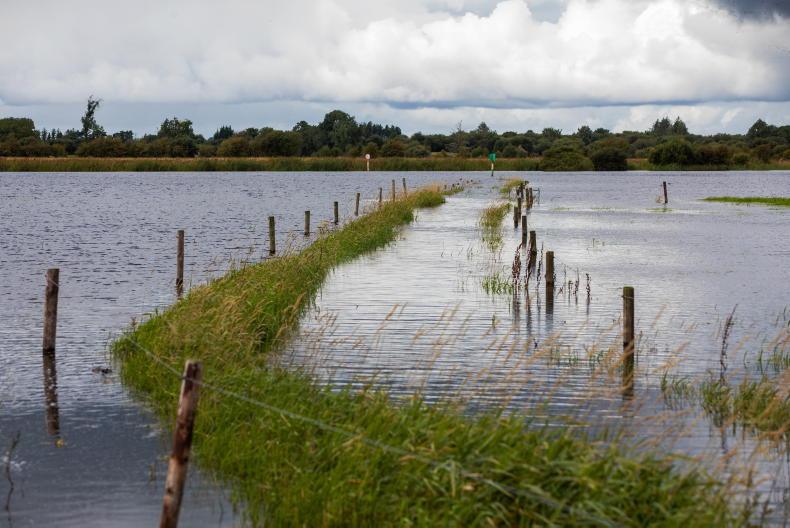Met Éireann has warned that the frequency and severity of climate and weather extremes is increasing in Ireland.
The national forecaster spoke at the Grassland Climate Adaptation Conference at the Teagasc Research and Innovation Centre on Tuesday 15 October.
Ireland’s climate is 0.7°C warmer and 7% wetter when comparing the average period of 1991-2020 to 1961-1990, according to Met Éireann.
Dr Padraig Flattery said there would be more affects to climate change for farming.
“Likely outcomes of further warming are extended grass growing season, rainfall increasing in likelihood and intensity, prolonged heatwaves and droughts, higher extreme temperatures [and] fewer cold extremes.”
Grass
He said that Irish grassland livestock production systems will have a lot more climate challenges ahead.
In 2024, Ireland experienced a wet and cold spring, combined with intermittent dry periods throughout the summer, both having impacts on grass growth.
Head of the Teagasc grassland science department professor Michael O’Donovan said there is clear evidence that farmers are adapting to the current challenges, as some technologies take time to bed into practises.
“In the last 10 years of PastureBase Ireland, grazing management practise has improved on Irish farms, spring grazing is now taking place earlier, increased grazing events are happening on paddocks, grass dry matter (DM) production is averaging approximately 13 tonnes DM per hectare per annum.

Pictured is a section of the attendance at a Teagasc Climate Adaptation Conference in the Animal & Grassland Research and Innovation Centre, Moorepark, Fermoy, Co. Cork. Picture: O'Gorman Photography.
“The transition to grass/clover swards is well under way on Irish grassland farms.”
Meanwhile, Teagasc grassland modeller Dr Elodie Ruelle said they expect overall grass output to be similar between years, with increases in winter growth and the variability of summer growth.
“We will experience some extremes in moisture deficits, so grassland systems will have to build resilience to cope with such extremes.”
Conference
The Grassland Climate Adaptation Conference took place at Moorepark, Fermoy, Co Cork, and focused on the key adaptations which are required to materialise in Irish grassland in the years ahead.
Delegates from New Zealand, Australia, the United Kingdom and Europe attended the meeting, with key speakers from groups such as Met Eireann, PGG Wrightsons seeds New Zealand and INRAe France.
Opening the conference, Teagasc director professor Frank O’Meara said the State agency is focused on trying to best position farmers for the key climate challenges ahead.
“We have a number of key initiatives in this area - PastureBase Ireland, Moorepark St Gilles MoSt Grass growth model and AgNav are all working toward similar goals, the future proofing [of] Irish ruminant productions systems.
“We have heard today that there are real challenges ahead that we need to keep responding to. It will be important to support farmers with more climate-effective technologies in the years ahead.”
Met Éireann has warned that the frequency and severity of climate and weather extremes is increasing in Ireland.
The national forecaster spoke at the Grassland Climate Adaptation Conference at the Teagasc Research and Innovation Centre on Tuesday 15 October.
Ireland’s climate is 0.7°C warmer and 7% wetter when comparing the average period of 1991-2020 to 1961-1990, according to Met Éireann.
Dr Padraig Flattery said there would be more affects to climate change for farming.
“Likely outcomes of further warming are extended grass growing season, rainfall increasing in likelihood and intensity, prolonged heatwaves and droughts, higher extreme temperatures [and] fewer cold extremes.”
Grass
He said that Irish grassland livestock production systems will have a lot more climate challenges ahead.
In 2024, Ireland experienced a wet and cold spring, combined with intermittent dry periods throughout the summer, both having impacts on grass growth.
Head of the Teagasc grassland science department professor Michael O’Donovan said there is clear evidence that farmers are adapting to the current challenges, as some technologies take time to bed into practises.
“In the last 10 years of PastureBase Ireland, grazing management practise has improved on Irish farms, spring grazing is now taking place earlier, increased grazing events are happening on paddocks, grass dry matter (DM) production is averaging approximately 13 tonnes DM per hectare per annum.

Pictured is a section of the attendance at a Teagasc Climate Adaptation Conference in the Animal & Grassland Research and Innovation Centre, Moorepark, Fermoy, Co. Cork. Picture: O'Gorman Photography.
“The transition to grass/clover swards is well under way on Irish grassland farms.”
Meanwhile, Teagasc grassland modeller Dr Elodie Ruelle said they expect overall grass output to be similar between years, with increases in winter growth and the variability of summer growth.
“We will experience some extremes in moisture deficits, so grassland systems will have to build resilience to cope with such extremes.”
Conference
The Grassland Climate Adaptation Conference took place at Moorepark, Fermoy, Co Cork, and focused on the key adaptations which are required to materialise in Irish grassland in the years ahead.
Delegates from New Zealand, Australia, the United Kingdom and Europe attended the meeting, with key speakers from groups such as Met Eireann, PGG Wrightsons seeds New Zealand and INRAe France.
Opening the conference, Teagasc director professor Frank O’Meara said the State agency is focused on trying to best position farmers for the key climate challenges ahead.
“We have a number of key initiatives in this area - PastureBase Ireland, Moorepark St Gilles MoSt Grass growth model and AgNav are all working toward similar goals, the future proofing [of] Irish ruminant productions systems.
“We have heard today that there are real challenges ahead that we need to keep responding to. It will be important to support farmers with more climate-effective technologies in the years ahead.”







 This is a subscriber-only article
This is a subscriber-only article










SHARING OPTIONS: